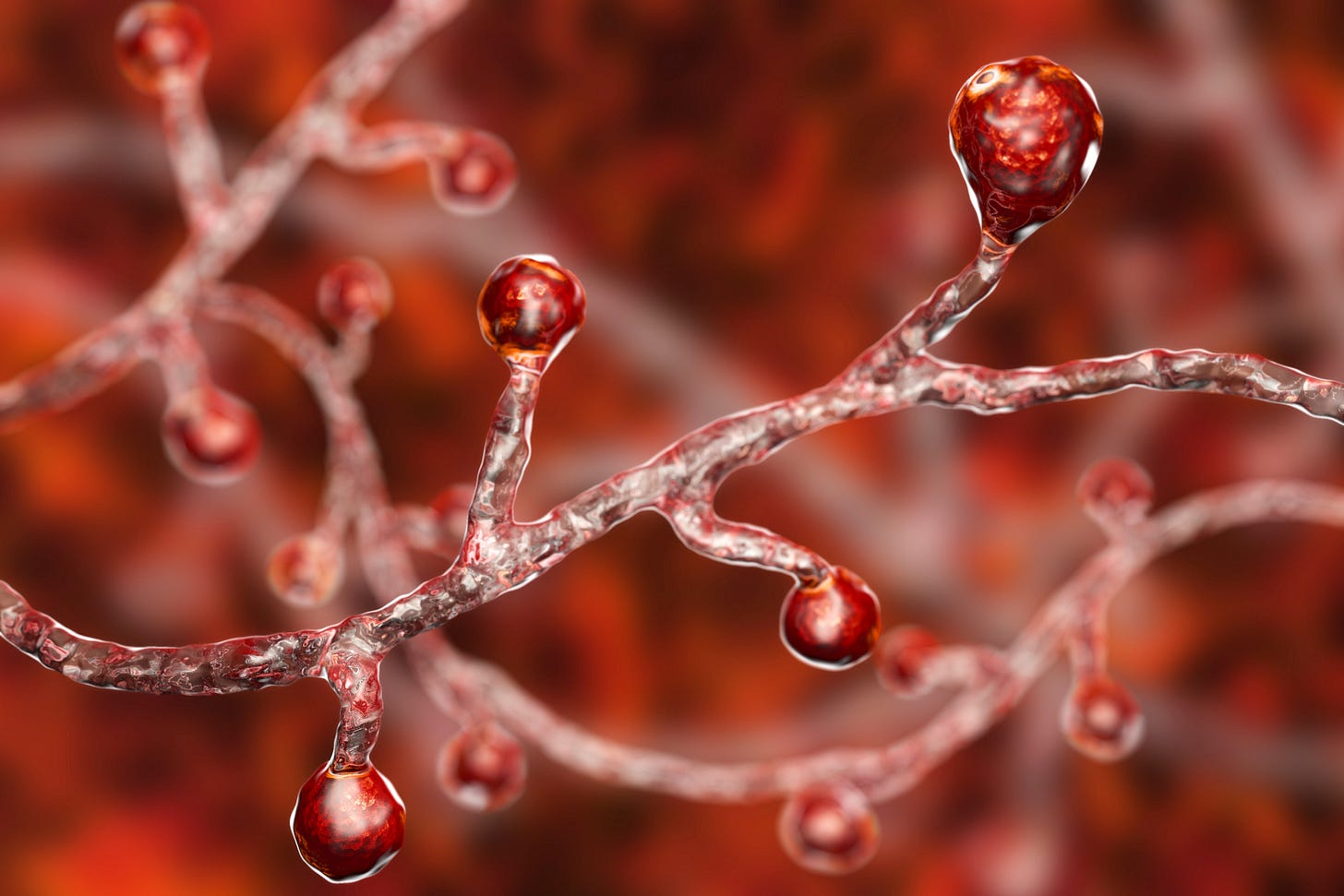Mycotoxins: An Introduction for Everyone
The real science of mycotoxins that every mold-illness patient should know BEFORE you spend money on sampling.
Blastomyces dermatitidis , colored image, showing the hyphae, or filaments, and globe-like structures forming spores for reproduction.
Mycotoxins are secondary metabolites produced by some fungi including molds. For the purposes of remediation and cleaning, the following apply:
Mycotoxins can be found on mold particles in the settled dust on surfaces in water damaged indoor environments (Bloom, 2009).
Mycotoxins can be considered part of or attached to hyphae (filaments), ECM, and spores.
There are over 300 identified mycotoxins to date. Examples include ochratoxin, aflatoxin, fumonosins, and tricothocenes.
One mold species may produce many different mycotoxins, several species may produce the same mycotoxin, and sometimes no mycotoxins are produced by the same species.
Mycotoxins are not mVOC’s and do not behave as a gas.
Mycotoxins have significantly different chemical structure and composition than mVOC’s.
The following is additional information intended to be helpful for the person interested in remediating mycotoxins:
Mycotoxins can be effectively remediated (removed) and overall concentrations greatly reduced by using the same remediation process and methods as used for mold particulates and contaminated dust.
No chemical processes (e.g., enzyme, ultraviolet, ionization, or oxidation reactions) are known to sufficiently denature the reactive functional groups or destroy the molecular structure of all the possible mycotoxins in any mold contaminated environment to achieve an acceptable return to a normal fungal ecology (“Condition 1”, per the S520).
Mycotoxins, like mold spores, can appear anywhere at any time due to natural distribution (i.e., ubiquitous). Therefore, zero tolerance for the presence of spores and mycotoxins in a residential or workplace building is unlikely to be achievable.
Sampling and identification of mycotoxins in the indoor environment, whether airborne or settled, is difficult and is not a consistently reliable method (i.e., low precision and accuracy). This is in part due to the fact that production of mycotoxins is highly variable and unpredictable and is influenced by the type of material (growth substrate), temperature, and available water .
Correlating airborne mycotoxins to growth in a building is difficult if not impossible. In addition, one mold species may produce many different mycotoxins, several species may produce the same mycotoxin, and sometimes no mycotoxins are produced by the same species. Mycotoxin sampling for post remediation verification purposes has not been validated at the time of this writing.
Exposure to mycotoxins in a water damaged building will likely be by inhalation of contaminated mold particulates. However, there are no government regulations for airborne mycotoxin concentration or exposure limits in water damaged buildings or the work place (e.g., U.S. and Canada as of 2022).
While unrelated to professional mold remediation of buildings, mycotoxins can be harmful to livestock and humans when food is grossly contaminated with mold growth. As a result, mycotoxin concentrations in some foods and animal feedstock are regulated by governments worldwide. There is no correlation between food contamination and building contamination.
Health effect mechanisms of very low mycotoxin concentration via inhalation exposure and dermal contact are poorly understood. There is little conclusive literature and documentation explaining the direct causation of illness by mold at the typical low airborne concentrations found in buildings. For example, some health professionals claim the presence of any mycotoxins or mold DNA to be the cause of inflammation-type illnesses but lack valid exposure and epidemiology data to confirm the connection.
Like non-mold toxins, it is recognized in the literature from around the world that the health effects of mold and its various compounds, e.g., irritants and allergens (see also Condition 2), are a function of the type, concentration, duration of exposure, and the individual's unique sensitivities.
Therefore, it is widely acknowledged that returning a mold contaminated building to a clean and dry condition (i.e., Condition 1) by properly remediating and removing the mold growth and correcting the water damage (per the S520 Mold Remediation Standard and the S500 Water Restoration Standard) will result in safer and healthier conditions for the occupant.
FUN FACT TO KNOW: Mycotoxins sometimes perform a defensive chemical mechanism against other micro-organisms in the surrounding highly competitive environment. This feature has been exploited for use as successful antibiotics, such as penicillin, a mycotoxin produced by Penicillium.


that was great but I am a little confused. I thought the remediation process included enzyme treatments and UV light. How do you get rid of the mycotoxins?
We've been calling the extracellular material, ECM. That way, it includes guttate and other broken fragments, spores, cell wall components, etc.
Whether tht is a significant exposure in a water damaged building remains to be seen.
the "worst" part of this is the dearth of environmental condition data. No one on the medical side understands exposure conditions (substrate, pathway, concentrations, loading factor, etc) therefore they ignore it and do not collect that data. They just claim things like "mycotoxins in urine" therefor there "must be" exposure. I provided expert input on a case where the doc said, "the illness existed therefor the mold had to have been there even if 3 sets of public and environmental health inspections found nothing, and even tho the water damage history was nill" - My client won. for obvious reason.